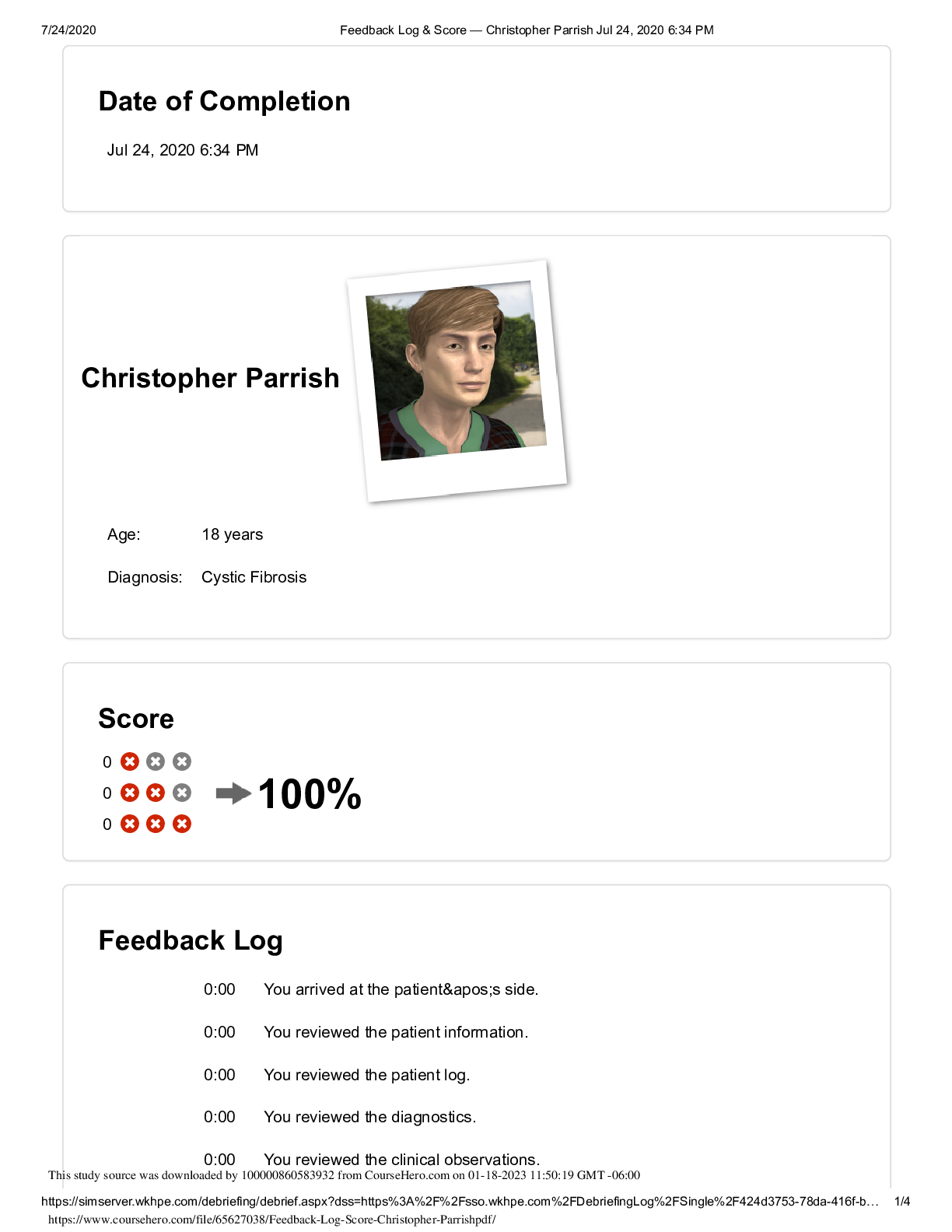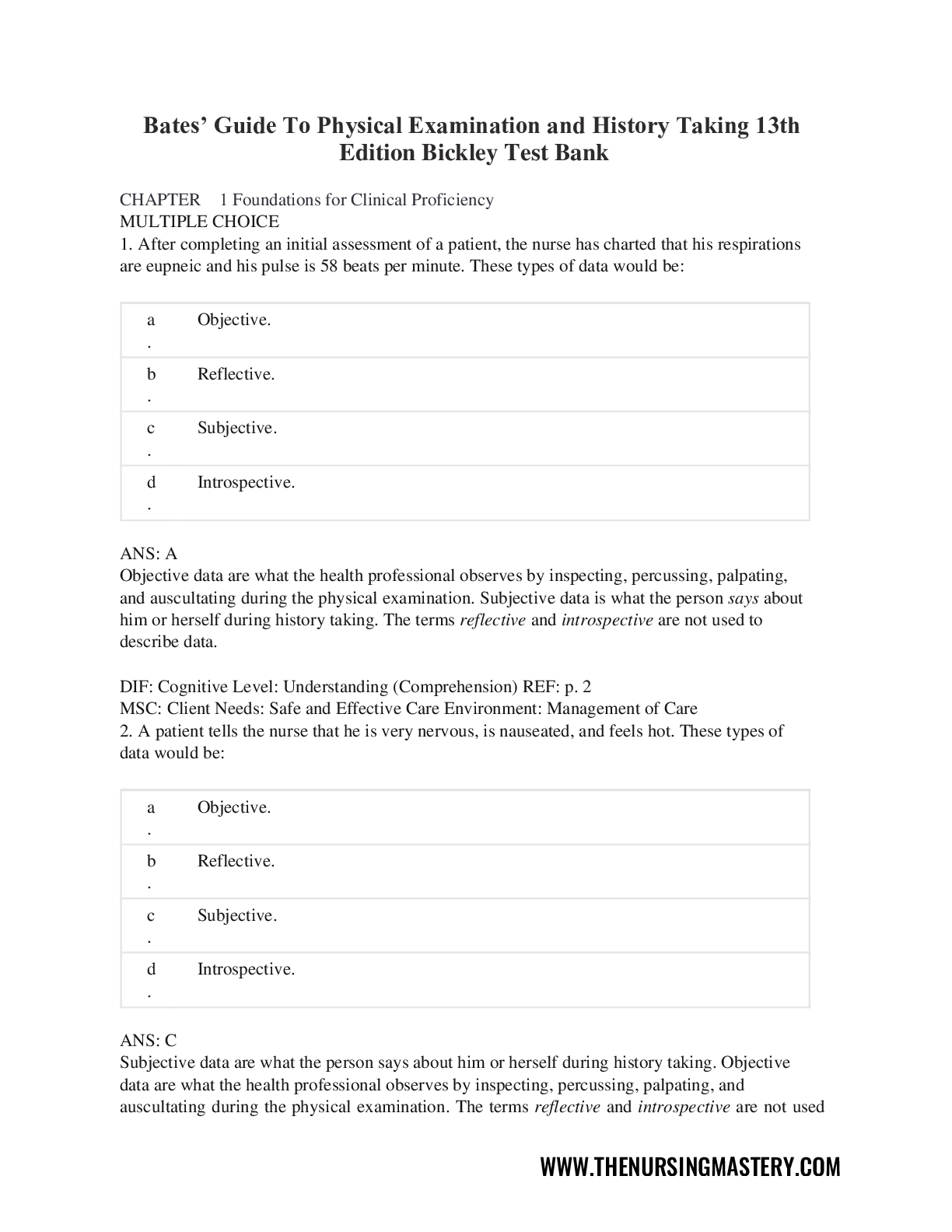BIO1011 WEEK 9 QUIZ SOUTH UNIVERSITY. Graded A LATEST FOR 2021/2022
Document Content and Description Below
Grading Summary These are the automatically computed results of your exam. Grades for essay questions, and comments from your instructor, are in the "Details" section below. Grade Details - Al l Quest... ions Student Answer: True False 5. Question : At the optic chiasm Student Answer: axons from the retinae synapse on those from the other half. axons from the temporal halves of each retina cross. axons from the nasal halves of each retina cross. both A and C both B and C 6. Question : Damage to the preoptic area of the hypothalamus leads to which problem? Student Answer: production of a large volume of urine an intense thirst an insatiable appetite reduced ability to regulate body temperature an uncontrolled sex drive 7. Question : In relation to the medial and lateral pathways, the pathway controls movements of trunk and limb muscles. Student Answer: lateral; precise; distal medial; fine; distal lateral; gross; distal medial; gross; distal medial; gross; proximal 8. Question : Cerebrospinal fluid enters the subarachnoid space through the Student Answer: falx cerebri. interventricular foramina. dural sinus. lateral and median apertures. aqueduct of Sylvius. Points Received: 1 of 1 Comments: 9. Question : The corpus callosum is composed of Student Answer: commissural fibers. arcuate fibers. association fibers. longitudinal fasciculi. projection fibers. 10. Question : The adult human brain contains almost of the body's neural tissue. Student Answer: 25 percent 68 percent 15 percent 97 percent none of the above 11. Question : The dural sinuses are located in the Student Answer: pia mater. tentorium cerebelli. paranasal cavity. dural folds. arachnoid. 12. Question : There are pairs of cranial nerves. Student Answer: 6 2 12 22 31 13. Question : Figure 14-1 The Circulation of Cerebrospinal Fluid Use Figure 14-1 to answer the following questions: What is produced by the structure labeled "2"? Student Answer: white matter neurotransmitters cerebrospinal fluid hormones B and D Comments: 14. Question : Which of the following lies between the cerebrum and the brain stem? Student Answer: medulla oblongata diencephalon mesencephalon pons cerebellum 15. Question : Figure 15-2 The Corticospinal Pathway Use Figure 15-2 to answer the following questions: What occurs in this neural pathway at label "3"? Student Answer: decussation autonomic reflexes synapse communication between sensory and motor neurons amplification of motor signals 16. Question : A receptor potential may Student Answer: be a hyperpolarization. be a depolarization. decrease neurotransmitter release. increase neurotransmitter release. be any of the above 17. Question : Examples of sensory modalities include Student Answer: smell. warmth. vibration. touch. all of the above 18. Question : The corticospinal system is often referred to as the Student Answer: pyramidal system. spinothalamic tracts. red nucleus. medullary centers. reticular formation. 19. Question : The cerebellum adjusts motor activity in response to all of the following, except Student Answer: input from proprioceptors. touch sensations. visual information. equilibrium-related sensations. input from the motor cortex. 20. Question : Integrative centers concerned with the performance of complex processes are restricted to either the left or the right hemisphere. These complex processes include Student Answer: mathematical computation. speech. understanding spatial relationships. writing. all of the above 21. Question : The anterior nuclei of the thalamus Student Answer: receive axon collaterals from the optic nerve. secrete melatonin. are part of the limbic system. secrete pituitary hormones. both B and C 22. Question : Damage to the corpora quadrigemina would interfere with Student Answer: visual and auditory reflex movements of the head and neck. conscious control of skeletal muscles. regulation of body temperature. control of autonomic function. control of breathing. 23. Question : Which ascending tract carries the sensations for fine touch and vibration? Student Answer: corticospinal posterior (dorsal) column corticobulbar spinothalamic both C and D 24. Question : A person with a damaged visual association area may be Student Answer: unable to understand spoken words. unable to recognize letters but able to identify whole words and their meanings. able to see letters but unable to associate them into words. declared legally blind. unable to see rows of letters. 25. Question : During embryonic development, which of the following secondary brain vesicles will form the cerebrum? Student Answer: metencephalon diencephalon telencephalon myelencephalon mesencephalon 26. Question : Damage to the premotor cortex of the frontal lobe would interfere with the ability to Student Answer: understand spoken words. understand visual images. sense the texture of velvet. play the piano. understand written words. 27. Question : Cerebrospinal fluid Student Answer: is formed by a passive process. is secreted by ependymal cells. is normally produced twice as fast as it is removed. has almost the same composition as blood plasma. both B and D Points Received: 1 of 1 Comments: 28. Question : Thalamic neurons that project to the primary sensory cortex are neurons. Student Answer: receptor first-order second-order third-order fourth-order 29. Question : Epileptic seizures that resist drug treatment are sometimes treated by surgically cutting through the corpus callosum. Student Answer: True False 30. Question : Mechanoreceptors might detect which of the following sensations? Student Answer: touch muscle length pressure vibration all of the above 31. Question : The provides the principal link between the nervous and endocrine systems. Student Answer: pons hypothalamus medulla oblongata cerebellum cerebrum 32. Question : The is located at the tip of the tail of the caudate nucleus. Student Answer: amygdaloid body putamen globus pallidus corpus striatum claustrum 33. Question : Jean needs to have a tooth in her mandible filled. Her dentist injects a local anesthetic to block pain afferents in one of her cranial nerves. What cranial nerve does the dentist numb? Student Answer: hypoglossal trigeminal glossopharyngeal trochlear facial 34. Question : The medial nuclei of the thalamus Student Answer: process olfactory information. produce the hormone oxytocin. process visual information. are part of the limbic system. connect emotional centers in the hypothalamus with the frontal lobe. 35. Question : A sensory receptor characterized peripherally as a free nerve ending and centrally uses glutamate and-or substance P as neurotransmitters, would most likely be a Student Answer: nociceptor. thermoreceptor. free receptor. mechanoreceptor. chemoreceptor. 36. Question : Which of the following is a function of the hypothalamus? Student Answer: secretes oxytocin produces ADH regulates body temperature controls autonomic centers all of the above 37. Question : Cortical regions that interpret sensory information or coordinate motor responses are called areas. Student Answer: association commissural processing sensory somesthetic 38. Question : Pain receptors are fast-adapting receptors. Student Answer: True False 39. Question : Absorption at the arachnoid granulations returns CSF to the Student Answer: central canal. venous circulation. third ventricle. fourth ventricle. arterial circulation. 40. Question : Nerve fiber bundles on the ventrolateral surface of the mesencephalon are the Student Answer: corpora quadrigemina. superior colliculi. cerebral peduncles. inferior colliculi. tegmenta. Points Received: 1 of 1 Comments: 41. Question : The thin partition that separates the first and second ventricles is the Student Answer: interventricular foramina. falx cerebri. septum pellucidum. septum insula. cerebral aqueduct. 42. Question : Tracts of the lateral and medial pathways include all of the following, except tracts. Student Answer: vestibulospinal rubrospinal corticospinal tectospinal reticulospinal 43. Question : The two cerebral hemispheres are separated by the Student Answer: central sulcus. postcentral sulcus. parieto-occipital sulcus. longitudinal fissure. transverse fissure. 44. Question : Which of the following is not a property of the limbic system? Student Answer: functions in maintaining homeostasis in cold weather functions in emotions, learning, and memory located between the border of the cerebrum and diencephalon contains cerebral and diencephalic components links conscious functions of the cerebral cortex with unconscious functions of the brain stem 45. Question : The descending spinal tract that crosses to the opposite side of the body within the medulla oblongata is the tract. Student Answer: lateral corticospinal vestibulospinal reticulospinal rubrospinal anterior corticospinal 46. Question : Mechanoreceptors that respond to changes in blood pressure are called Student Answer: baroreceptors. nociceptors. proprioceptors. thermoreceptors. chemoreceptors. 47. Question : The right hemisphere is usually the dominant hemisphere. Student Answer: True False 48. Question : Within each hemisphere, deep to the floor of the lateral ventricle, you will find the Student Answer: anterior commissures. motor association areas. visual cortex. auditory cortex. basal nuclei. 49. Question : The presence of many large, highly-branched Purkinje cells in a sample of brain tissue indicates that it came from the Student Answer: cerebral cortex. cerebellar cortex. pons. medulla. arbor vitae. 50. Question : A brain injury to a patient results in facial paralysis. Which descending tract is most likely affected? Student Answer: corticobulbar tract rubrospinal tract corticospinal tract tectospinal tract reticulospinal tract 51. Question : The cerebellum relies on information from Student Answer: motor commands from upper motor neurons. the inner ear as movements are under way. the eyes. proprioceptive sensations. all of the above 52. Question : The regions of the mesencephalon that issue subconscious motor commands that affect upper limb position and background muscle tone are the Student Answer: cerebral peduncles. red nuclei. inferior colliculi. tecta. superior colliculi. 53. Question : The choroid plexus produces CSF at a rate of about Student Answer: 500 mL-day . 50 mL-day. 250 mL-day. 150 mL-day 1000 mL-day. 54. Question : Figure 15-1 Spinothalamic Tracts Use Figure 15-1 to answer the following questions: Which of the following is true regarding the structure labeled "6"? 1. The synapse occurs between motor neurons. 2. The sensations may be filtered out. 3. The third-order neuron projects to the primary sensory cortex. 4. The third-order neuron's axon is identified. Student Answer: 3 only 1 and 4 3 and 4 2 only 1 and 3 55. Question : The upper motor neurons of the medial pathway are located within any of the following, except the Student Answer: superior colliculi. inferior colliculi. reticular formation. vestibular nuclei. mamillary bodies. 56. Question : Axons that decussate between the pyramids of the medulla oblongata belong to the tracts. Student Answer: anterior corticospinal rubrospinal vestibulospinal lateral corticospinal reticulospinal 57. Question : What structure is covered by many blood vessels and adheres tightly to the surface of the brain? Student Answer: pia mater arachnoid cranial plexus choroid plexus dura mater 58. Question : The tracts that connect the cerebellum to the brain stem are located in the Student Answer: diencephalon. thalamus. medulla oblongata. * Times are displayed in (GMT-07:00) Mountain Time (US & Canada) [Show More]
Last updated: 1 year ago
Preview 1 out of 33 pages
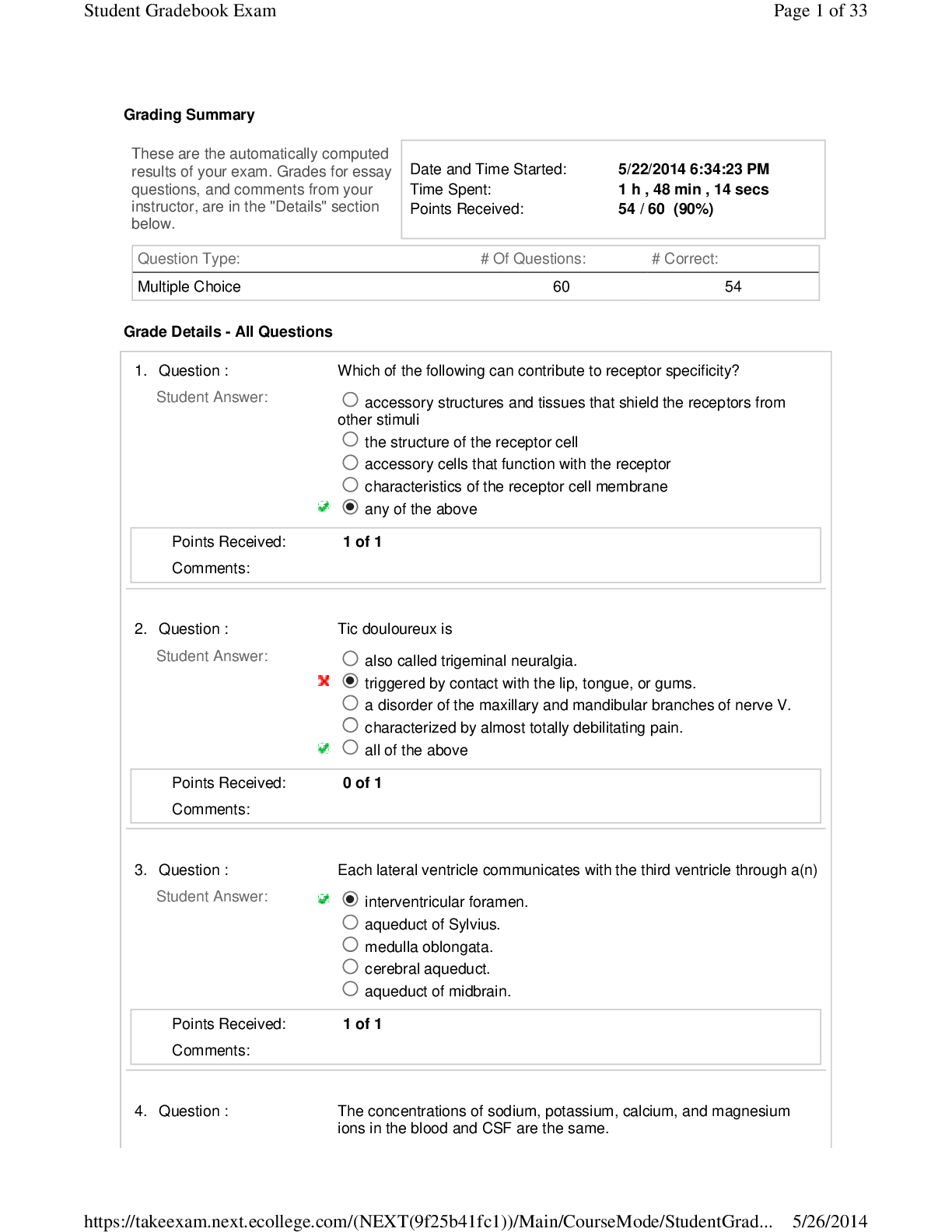
Reviews( 0 )
Document information
Connected school, study & course
About the document
Uploaded On
Aug 08, 2021
Number of pages
33
Written in
Additional information
This document has been written for:
Uploaded
Aug 08, 2021
Downloads
0
Views
34

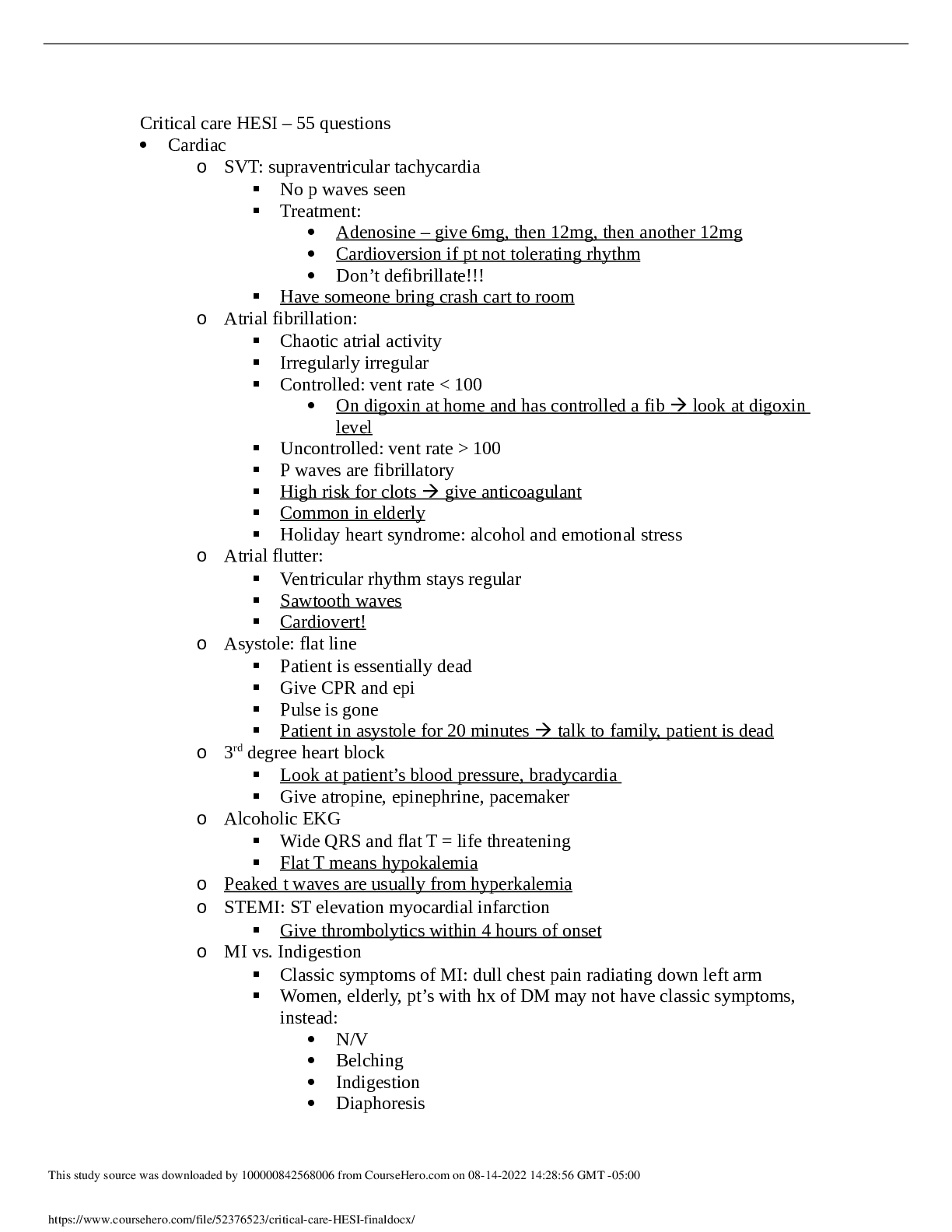
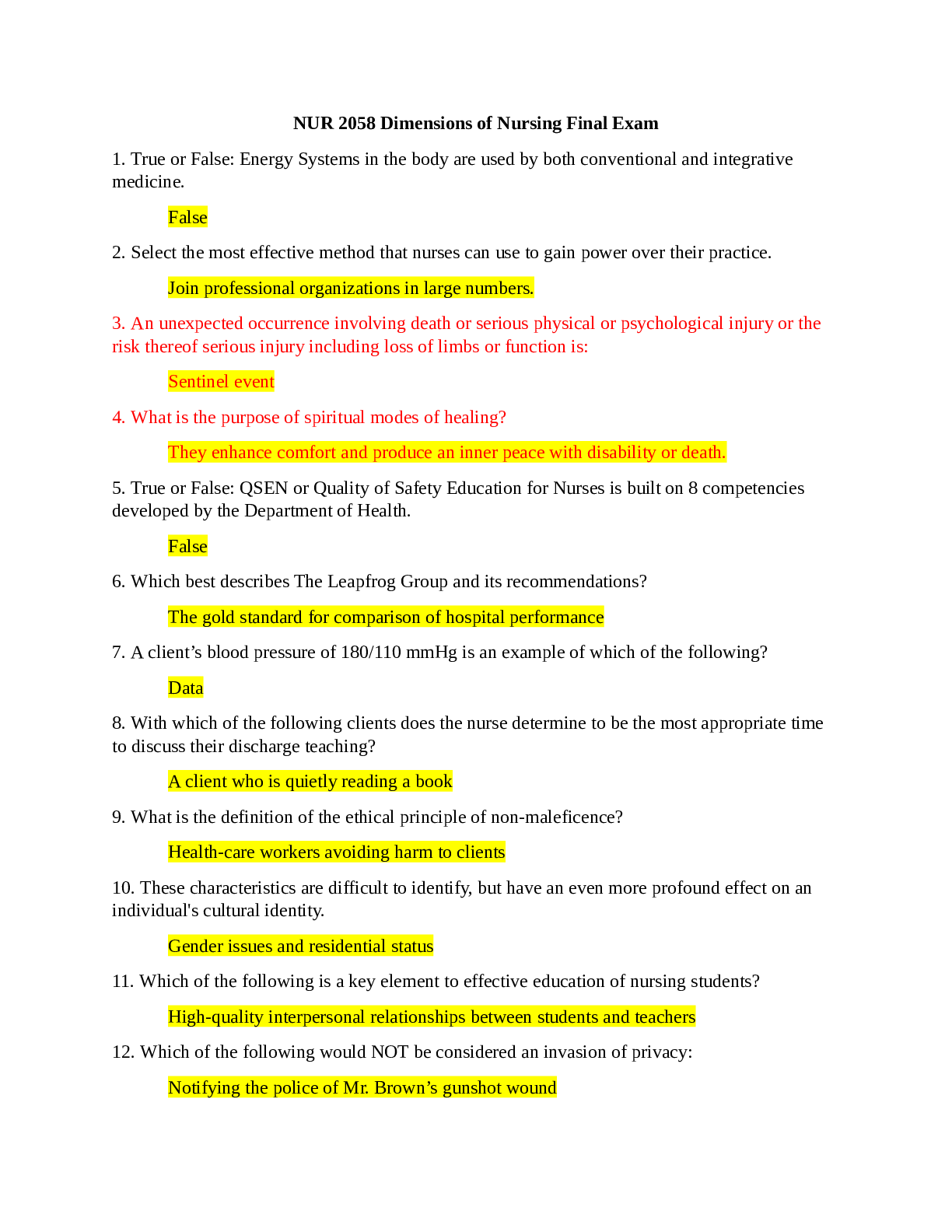




 Complete solutions.png)
 NURS 3247Pharmacology - Proctored Assessment,.png)

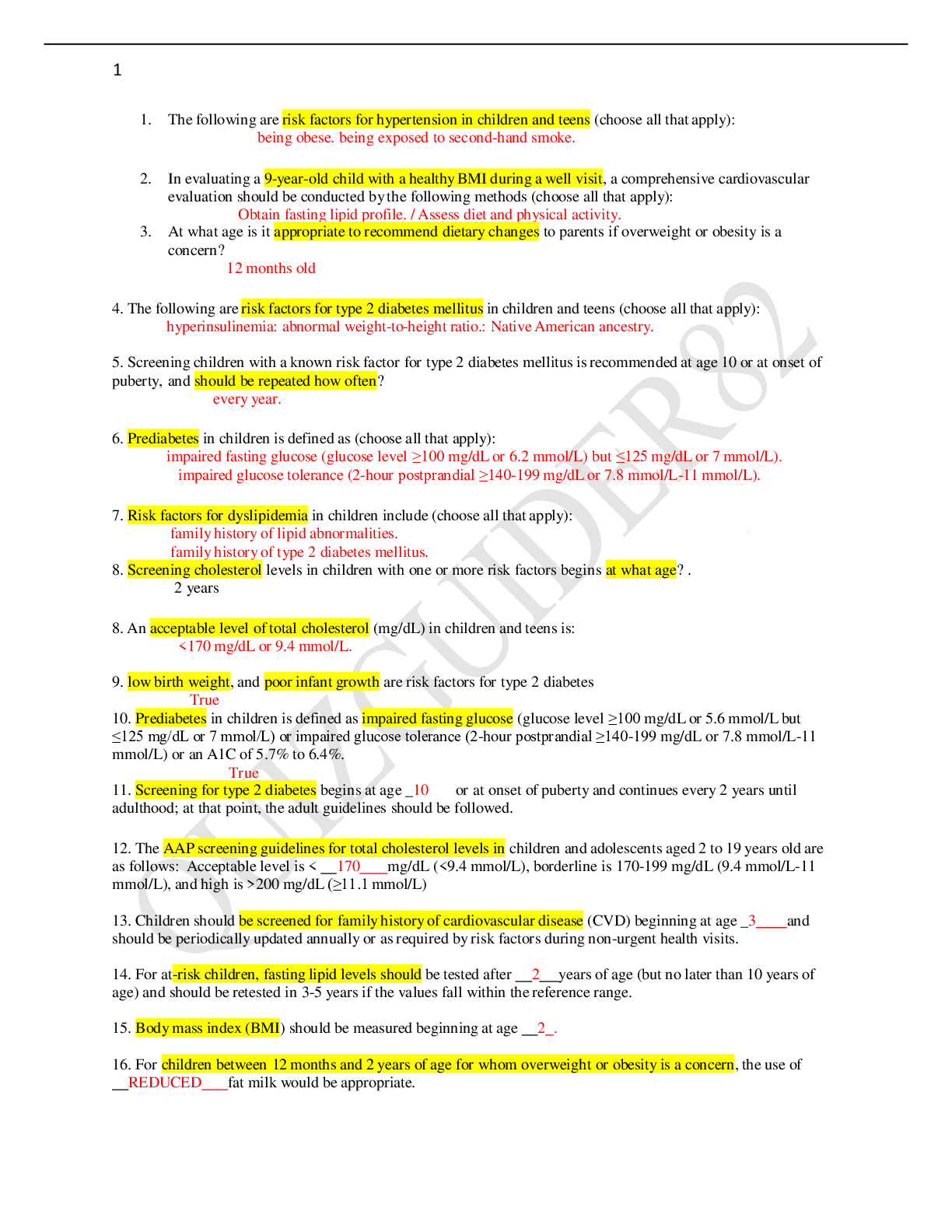

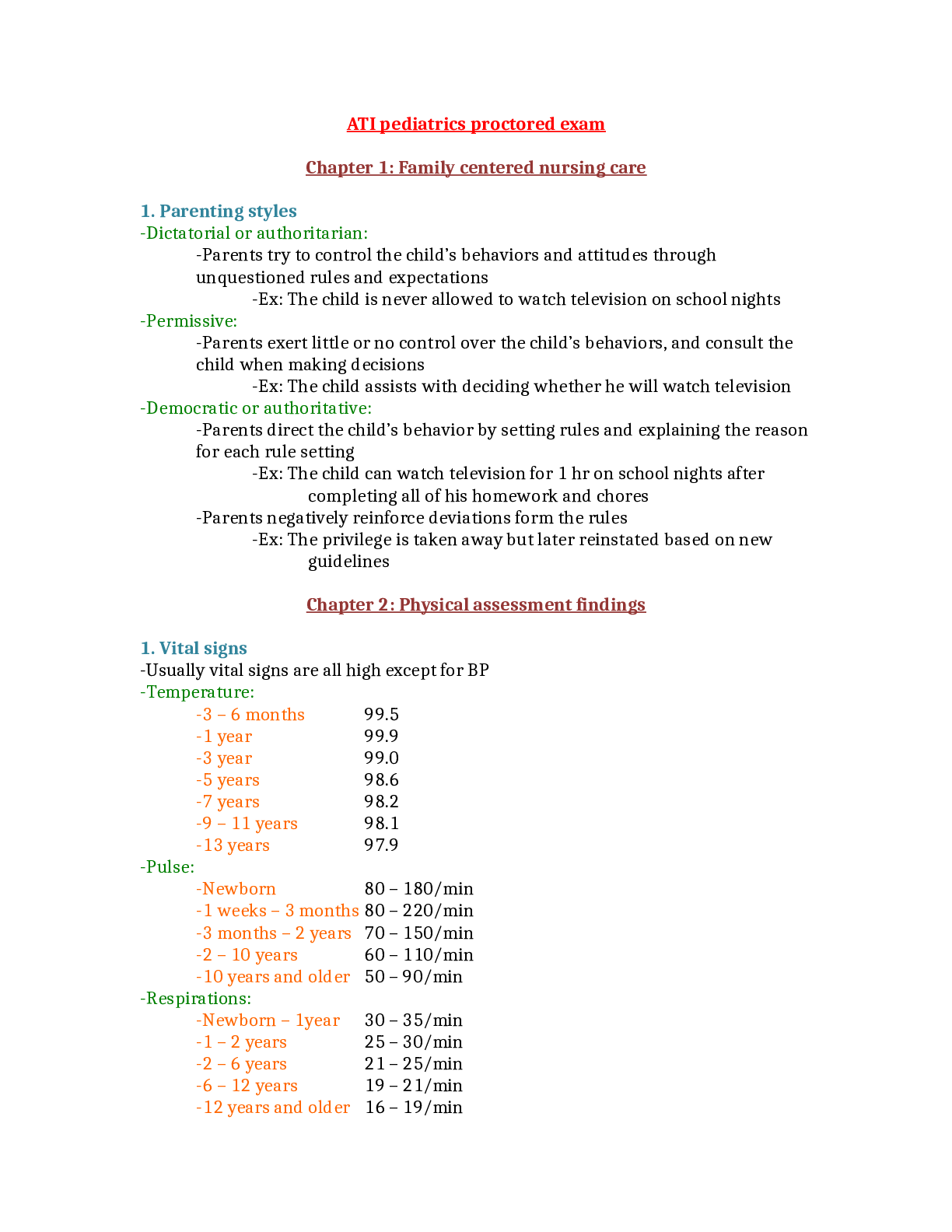
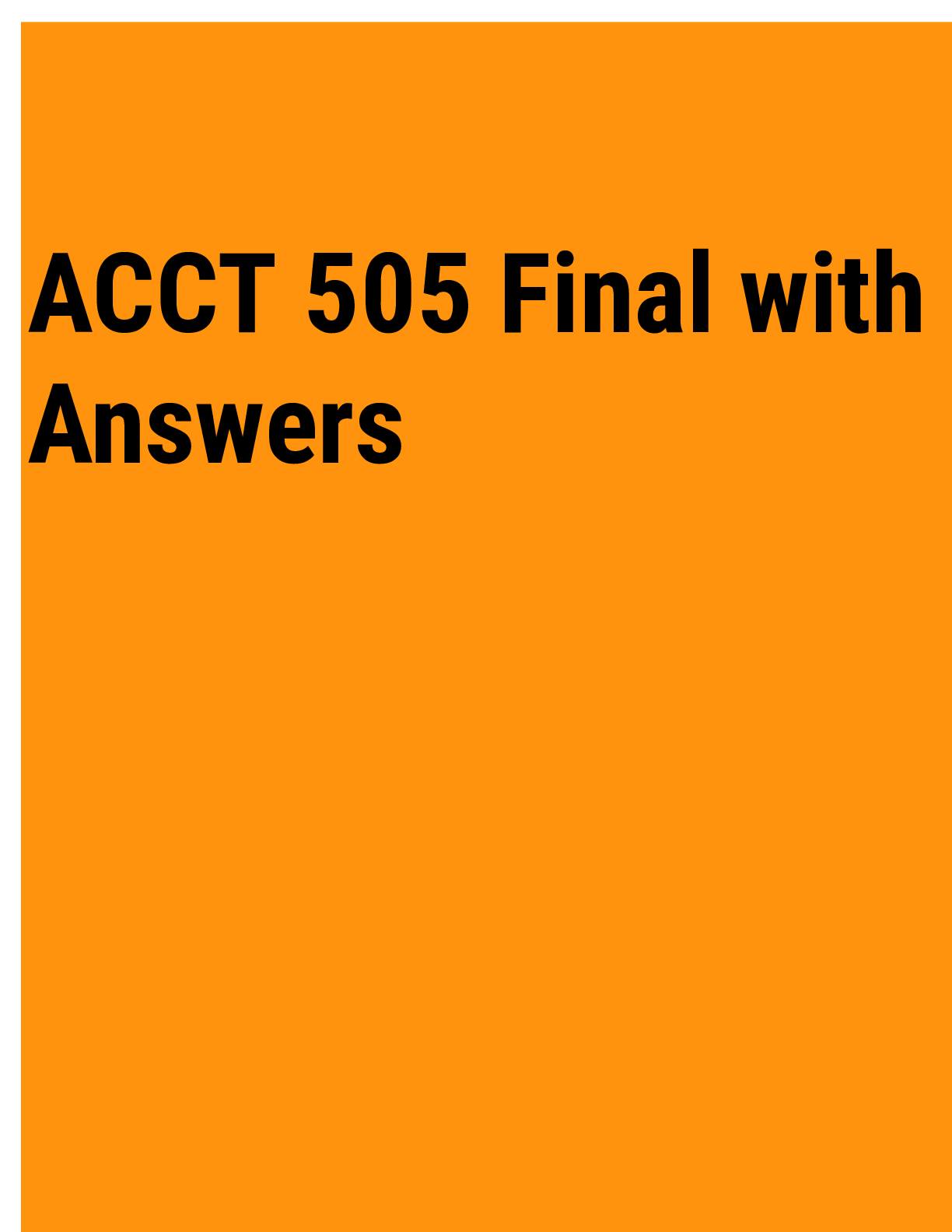

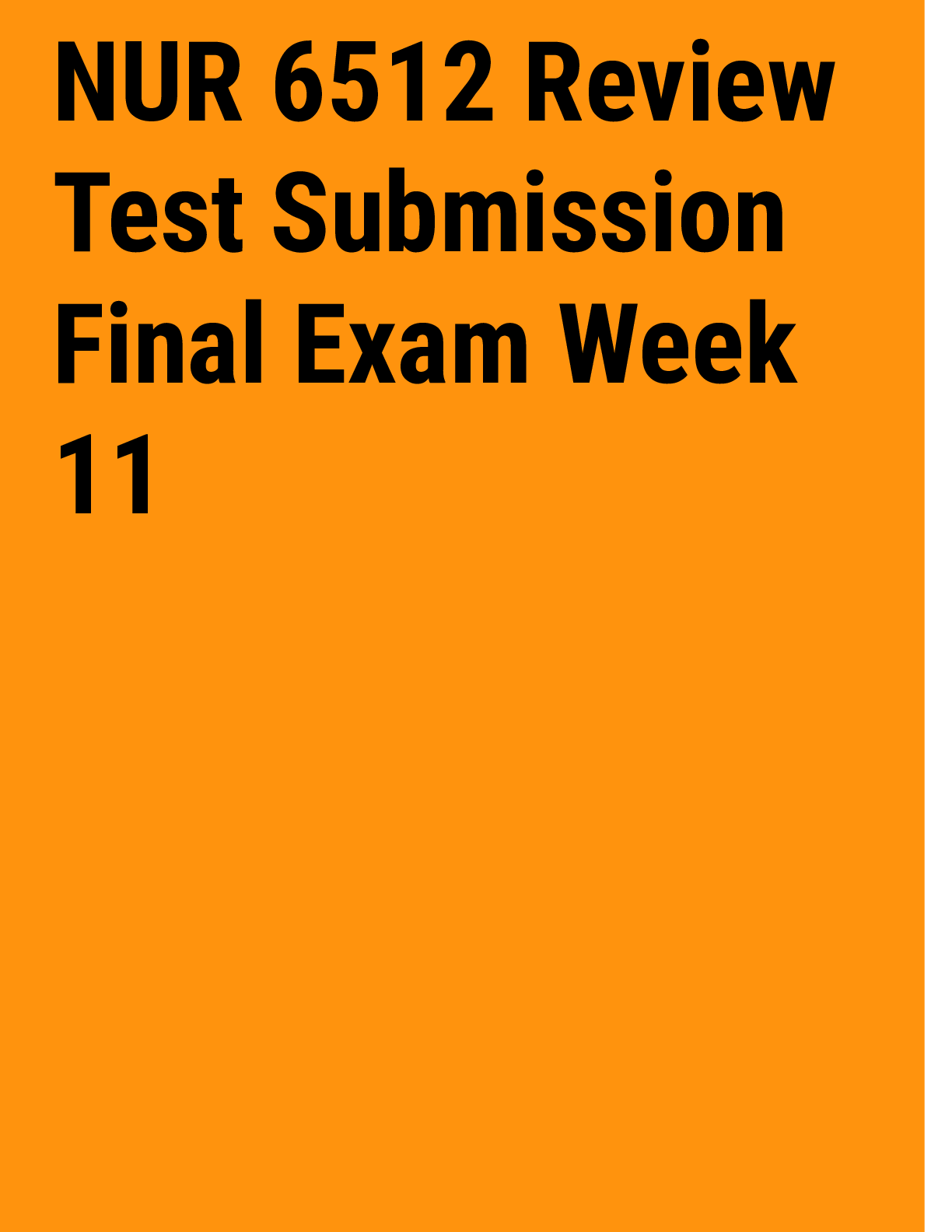
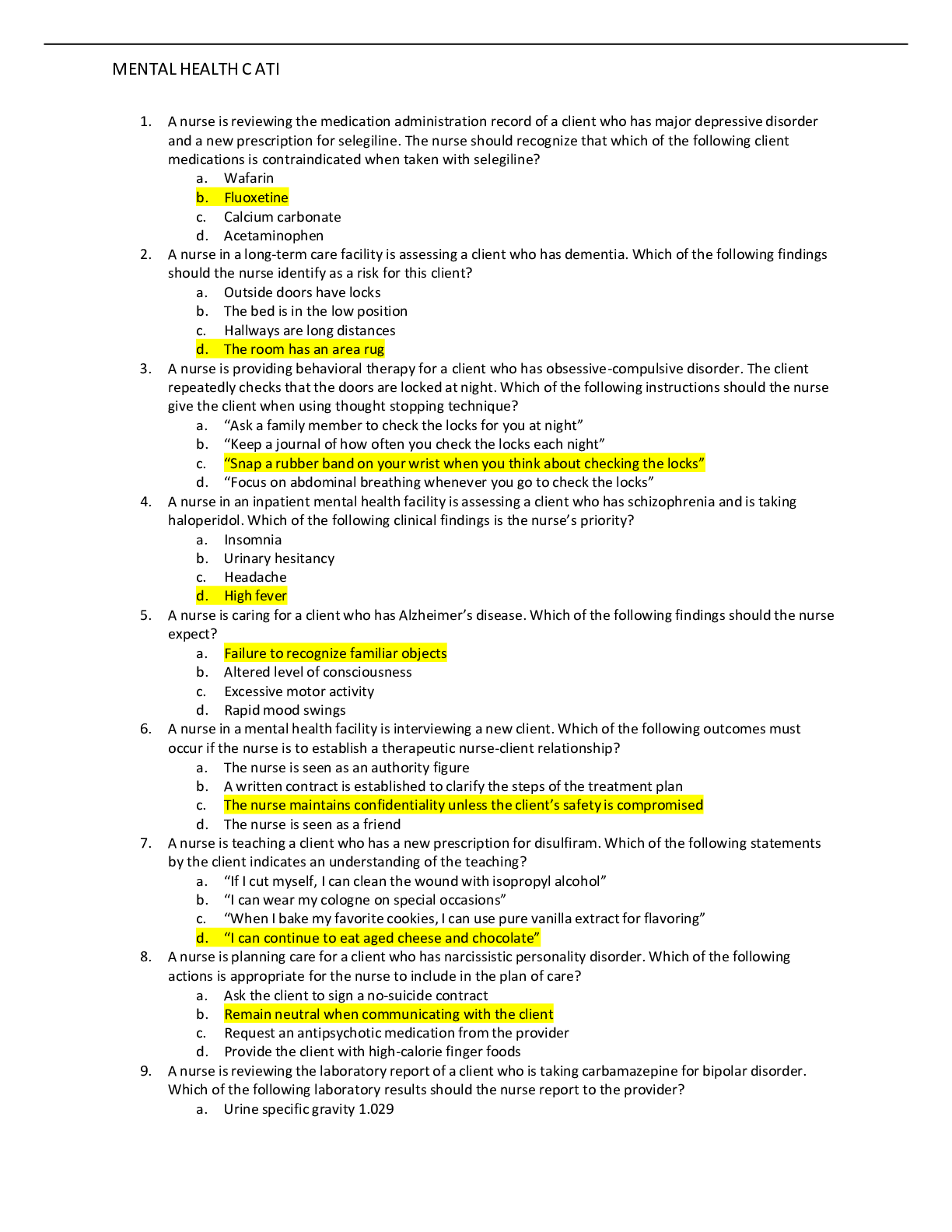
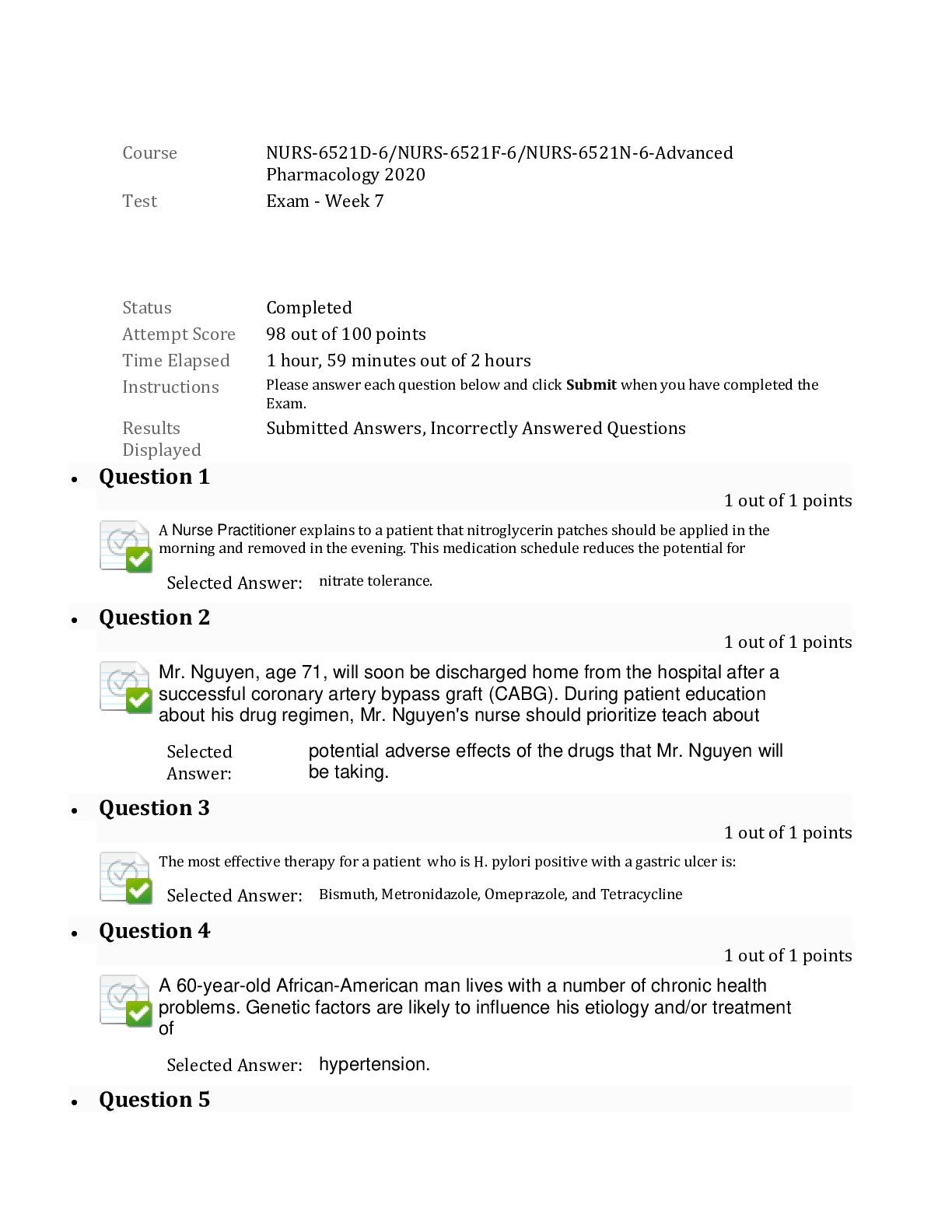
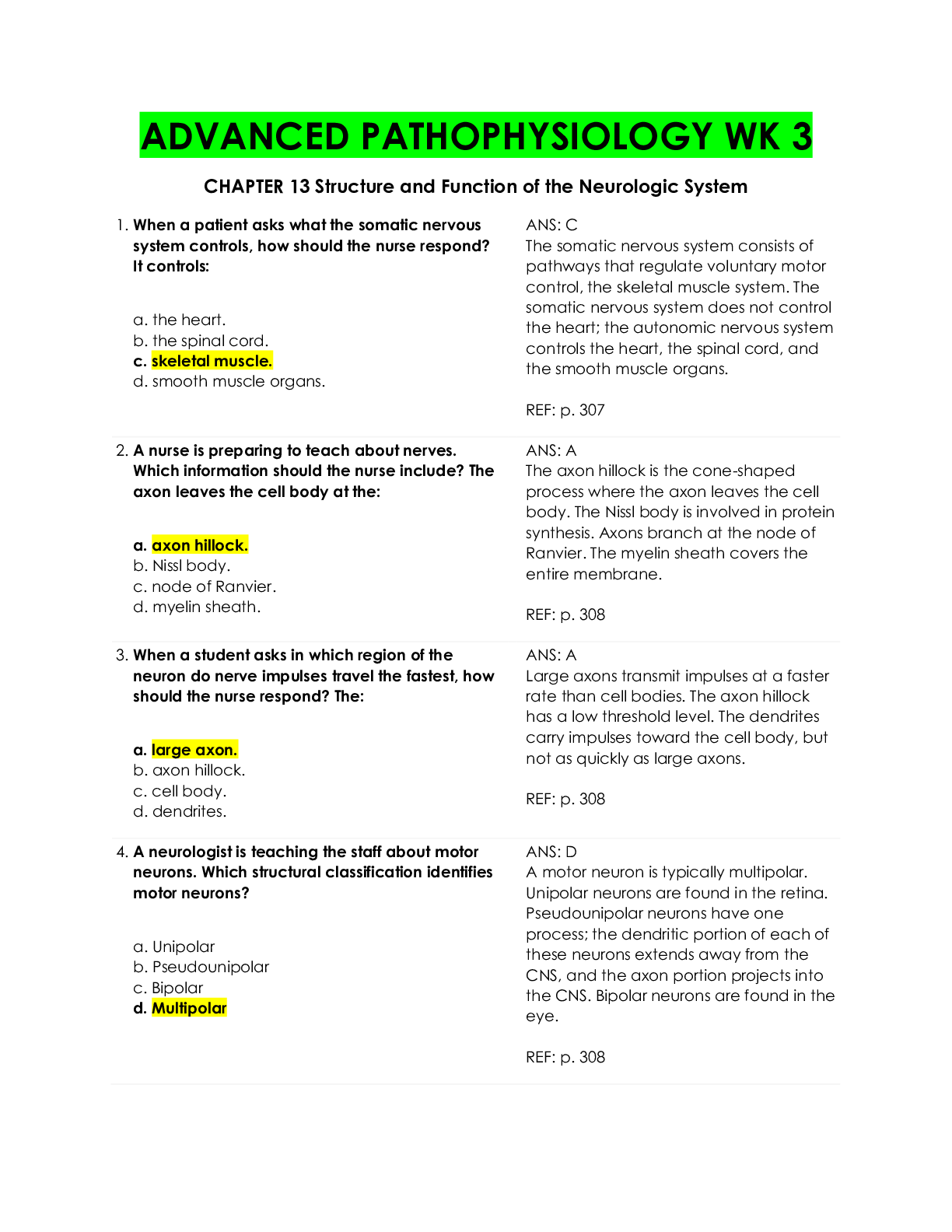
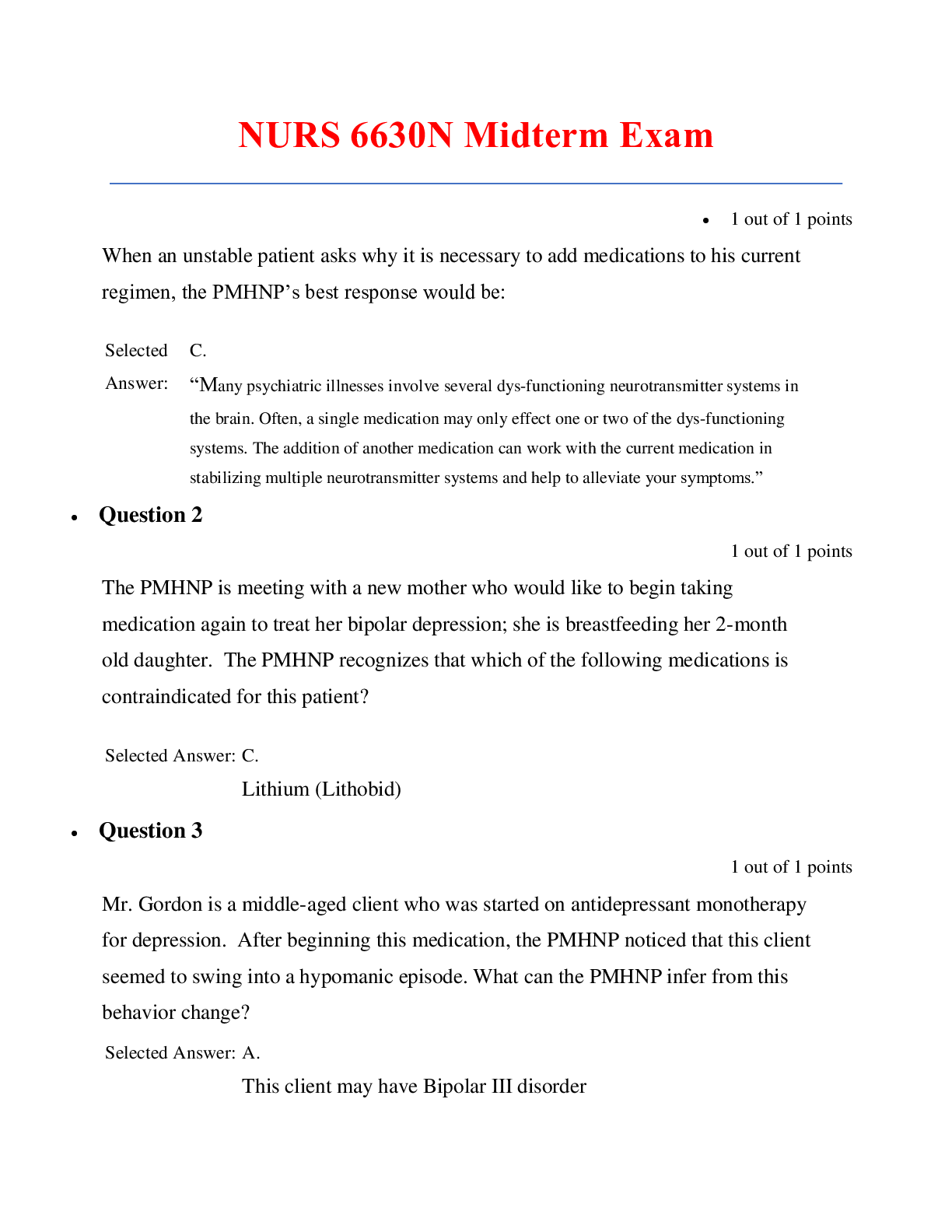
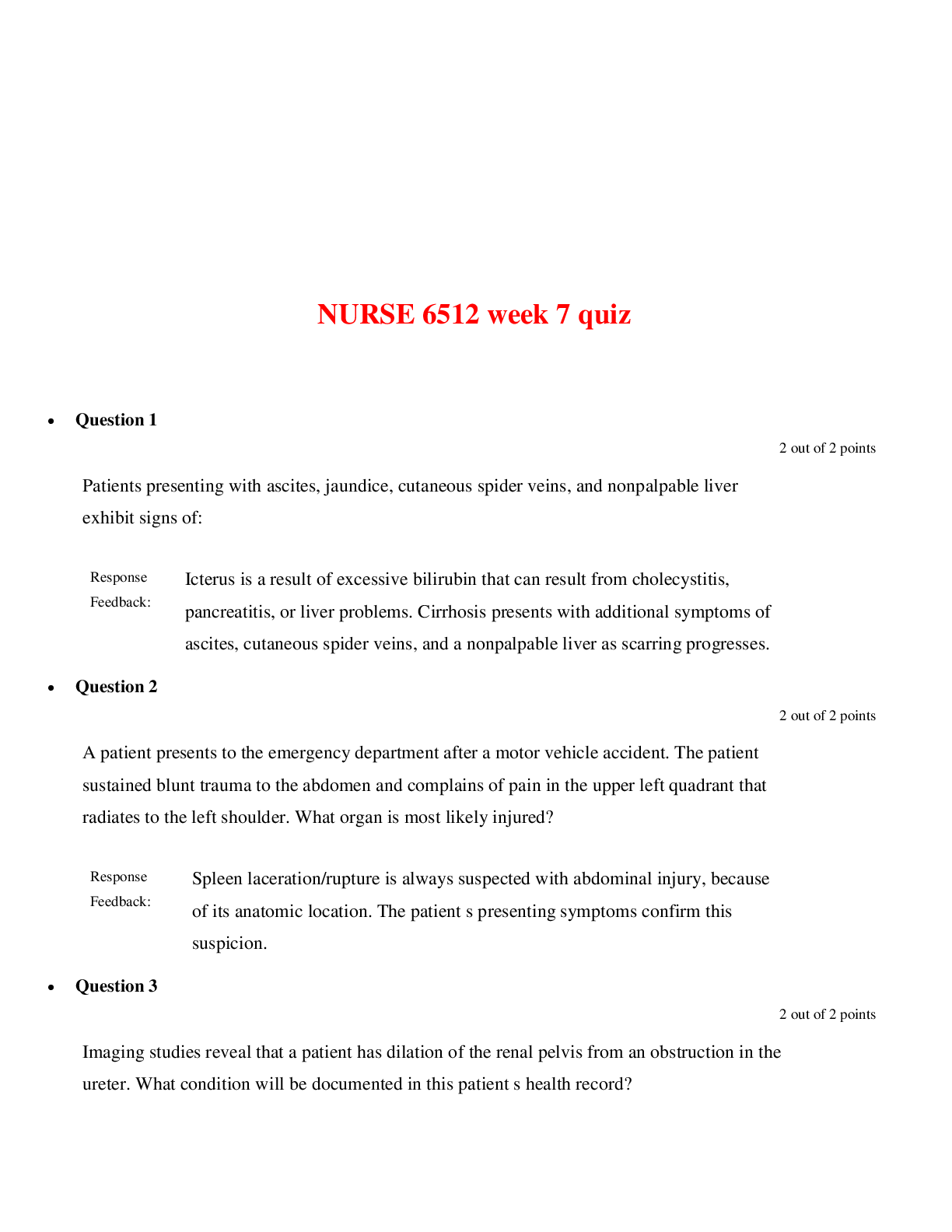
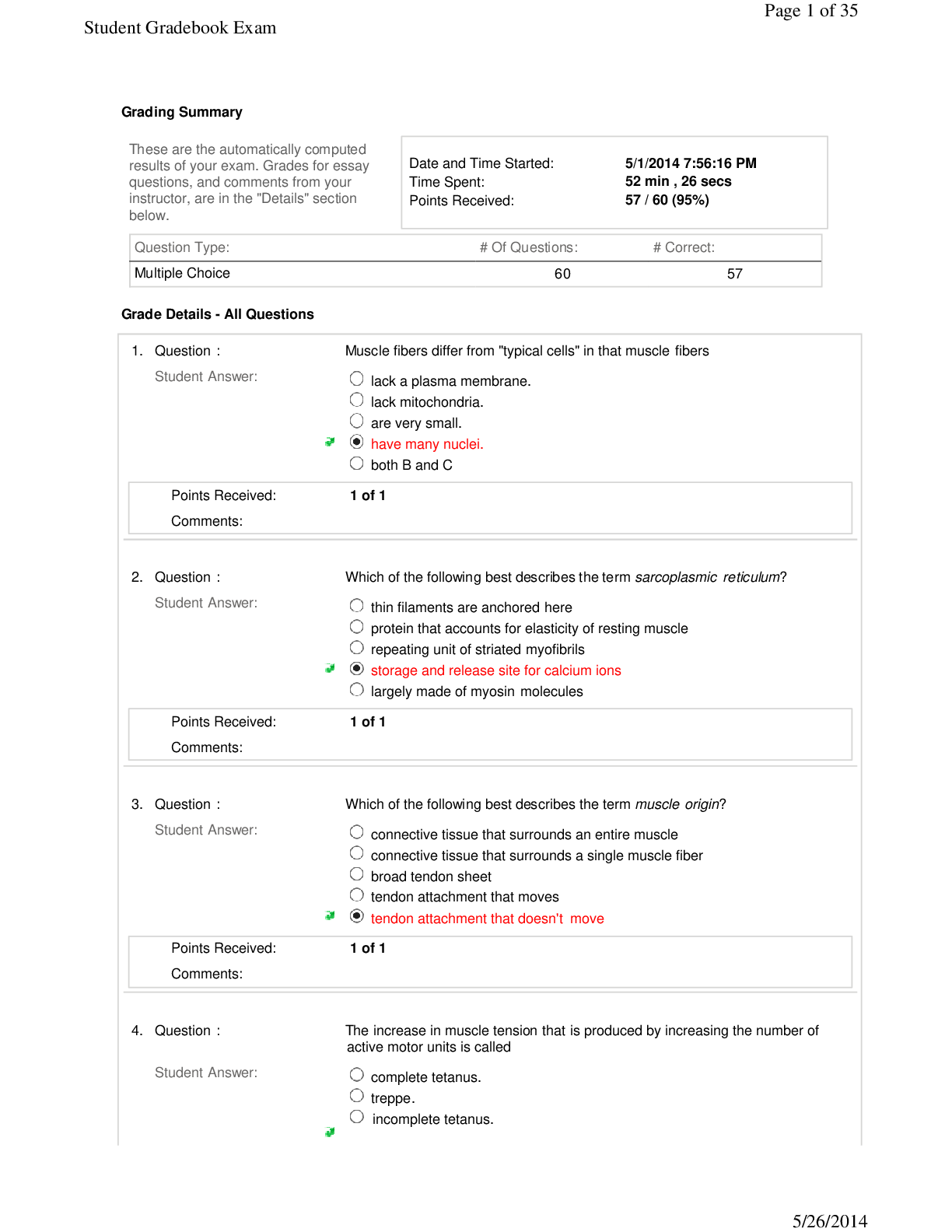
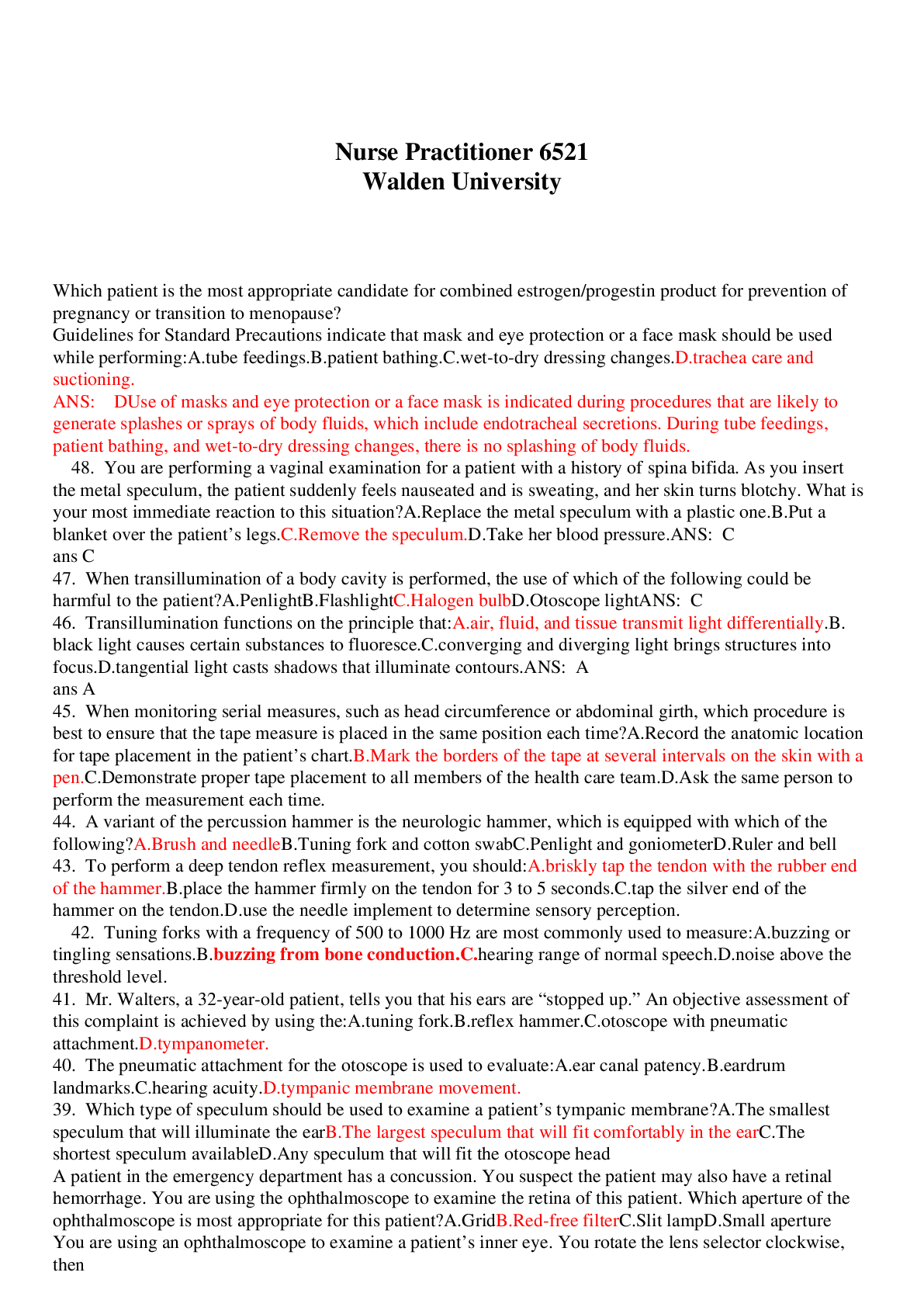

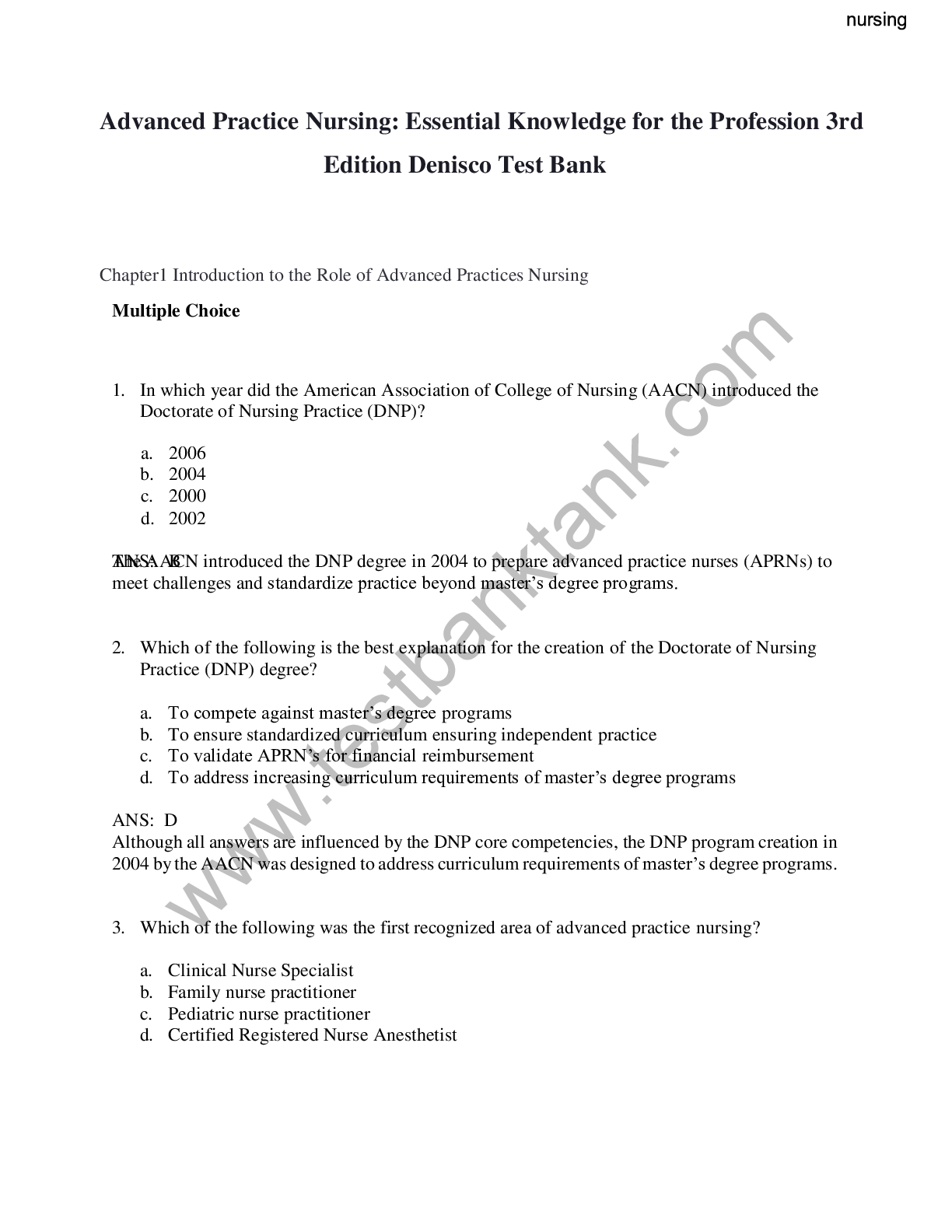
.png)

